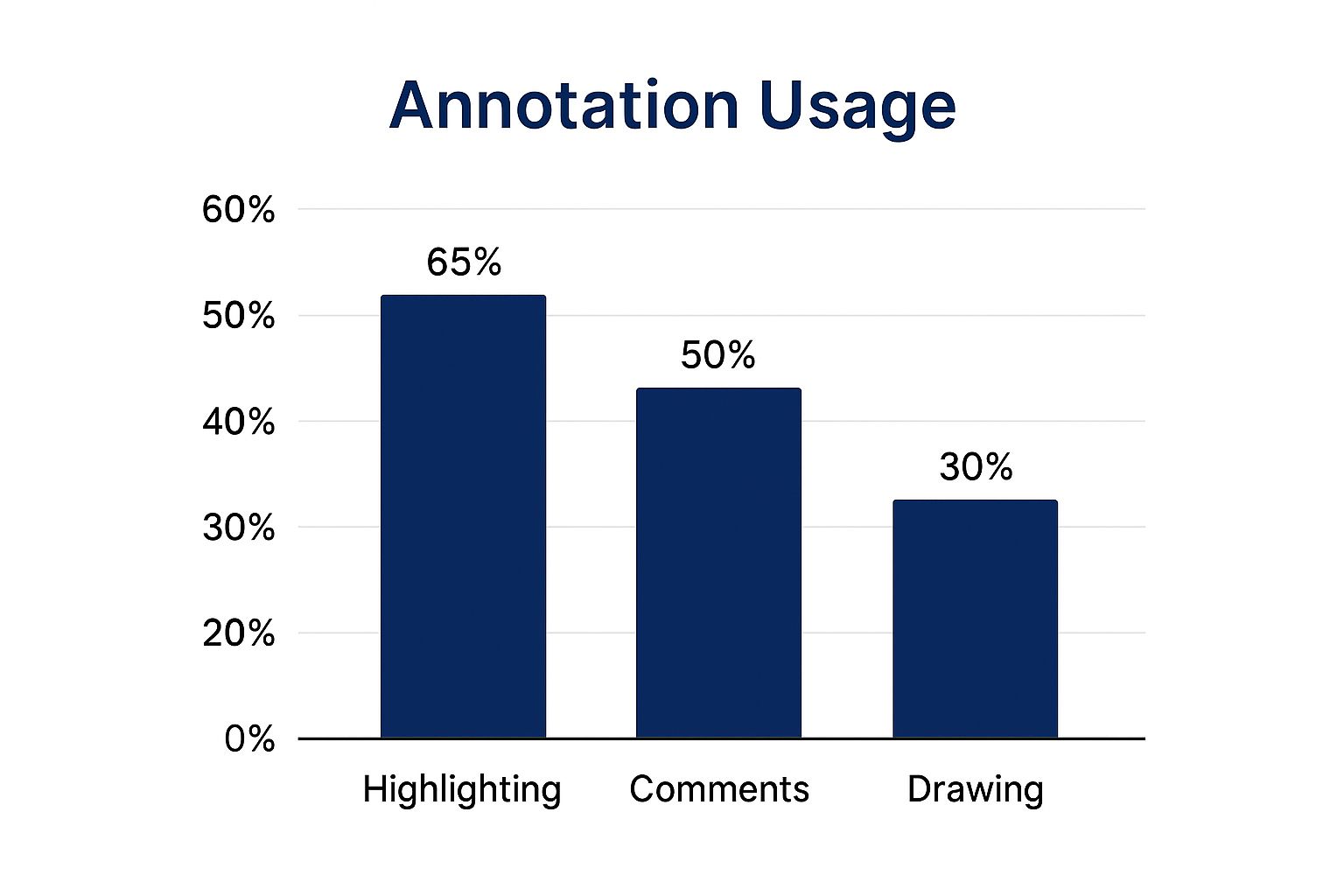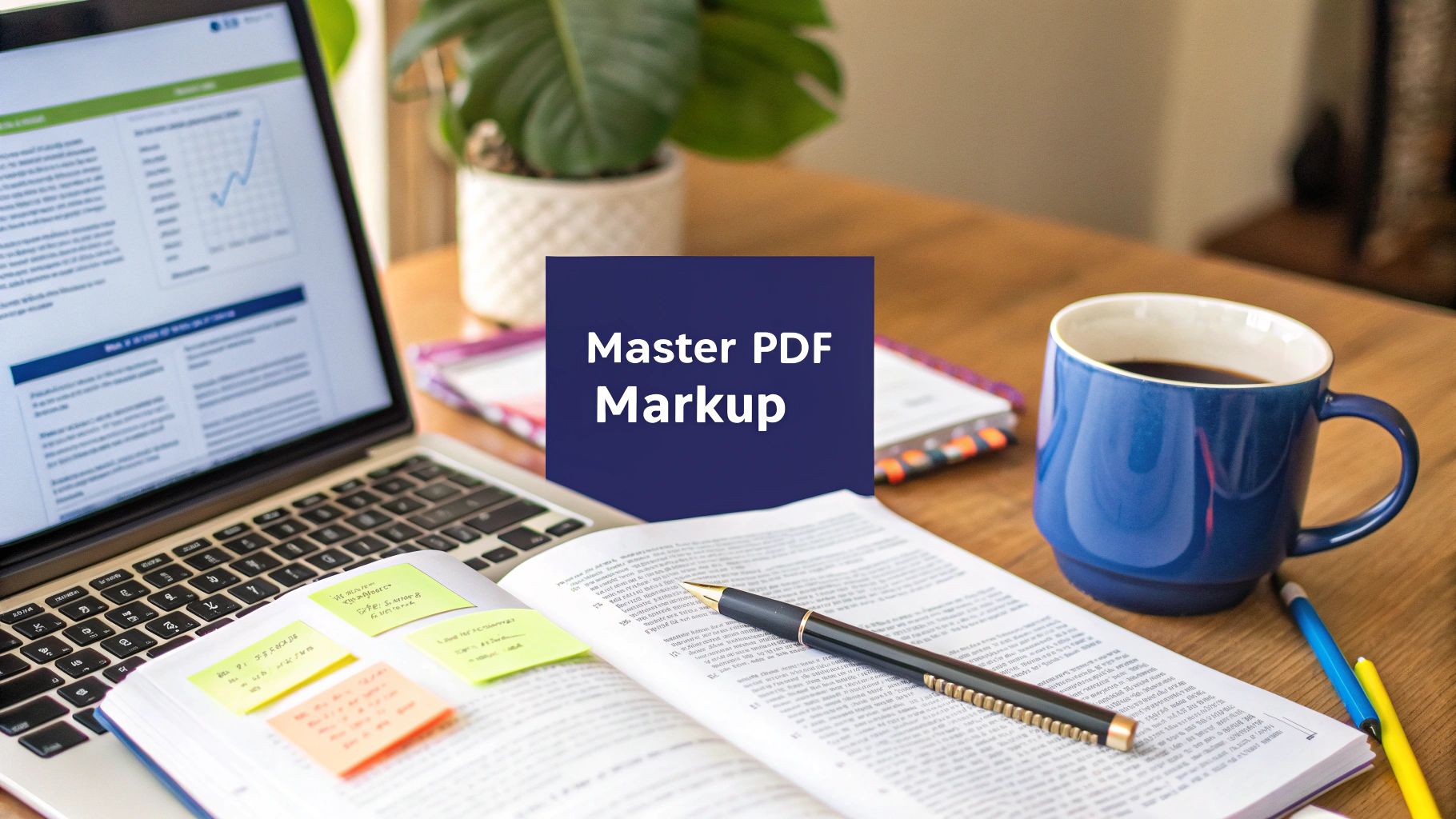Why Smart Professionals Are Obsessed With PDF Markup

Let's face it, marking up PDFs doesn't exactly sound like a party. But after years of witnessing the whirlwind of feedback chaos in various teams, I've come to appreciate the sheer power of effective PDF markup. Think back to your last project review. Smooth sailing, or a frustrating trawl through endless emails and conflicting comments? That's precisely where PDF markup steps in.
It's not just about digital sticky notes; it's about building a crystal-clear communication framework, ensuring everyone's on the same page, quite literally. This focused approach cuts through confusion and keeps projects moving forward. Imagine legal teams navigating tricky contract negotiations, or design agencies handling client feedback with pinpoint accuracy and clarity. That's the power of effective PDF markup.
Different sectors use this tool in their own unique ways. In software development, tools like BugSmash can be used for marking up PDF documentation to make sure everyone understands the specifications. For marketing teams, it’s vital for reviewing creative assets. And for legal professionals? Precision markup is absolutely essential for contract accuracy. This wide adoption shows how fundamental marking up PDFs is across diverse professional environments.
The Growth of PDF Markup
Speaking of widespread adoption, the PDF market is booming. The global PDF software market is expected to reach approximately USD 5.72 billion by 2033, growing at a CAGR of 11.47%. This shows not only the increasing importance of PDF documents but also the growing need for tools that make interacting with them better. Discover more insights into the growing PDF market.
This growth speaks volumes. Efficient PDF management, particularly through tools like BugSmash, is no longer a nice-to-have, it's a must-have for staying competitive. The right tools and techniques can significantly boost productivity and project success.
Finding Your Perfect PDF Markup Tool Match
Picking the right PDF markup software can be tricky. The price doesn't always equal value, especially when it comes to your specific needs. I've used everything from simple browser add-ons to hefty enterprise software, and honestly, the results often surprised me. Sometimes, the pricey options are amazing for team reviews but fall short on the detailed annotation features you might need for individual, in-depth work. Other times, a tool has incredible markup abilities, but sharing is a nightmare.
So, how do you find the perfect tool for the job? We'll skip the marketing fluff and get right to the practical stuff. Your needs as a solo freelancer are totally different from those of a 50-person design team. From my testing and conversations with other professionals, I've learned what's worth paying for and what's just extra baggage. A small team might find a free tool like BugSmash perfectly handles their PDF markup, making collaboration and feedback a breeze. Larger teams with more intricate workflows might need dedicated software with features like version control and custom permissions. On a Mac? Knowing how to reduce PDF file size on Mac can be a lifesaver when working with hefty documents.
Annotation Usage Breakdown
Take a look at this infographic. It shows how often different annotation features are used, based on a recent survey of professionals who regularly mark up PDFs.

Notice how highlighting dominates at 65%, followed by comments at 50% and drawing at 30%. This tells us something important: choose a tool that excels at these core functions. A user-friendly interface for these common tasks is key. Things like custom highlighting colors, threaded comment replies, and precise drawing tools can make a huge difference in your workflow.
The Expanding Market for PDF Markup Tools
The need for solid PDF markup tools is exploding. The market for PDF editor software was estimated at USD 2.86 billion in 2024. Find out more about the growing PDF editor software market. This growth reflects how more and more professionals are realizing how much efficient PDF markup can improve their work.
To help you choose the right tool, I've put together a comparison table based on my own experience.
To help you navigate the growing number of PDF markup tools, I've created a comparison table based on my real-world experience using them. It provides a quick overview of how different tools perform in various scenarios.
| Tool Name | Best Use Case | Standout Features | Collaboration Quality | Value Rating |
|---|---|---|---|---|
| BugSmash | Small teams, quick feedback | Simple interface, easy sharing | Excellent for basic collaboration | High (free plan available) |
| Adobe Acrobat | Complex projects, advanced editing | Extensive features, industry standard | Strong, but can be pricey | Medium (subscription required) |
| PDF Expert | Mac and iOS users, smooth annotation | Fast performance, Apple Pencil integration | Good for smaller teams | High |
| Xodo PDF Reader & Editor | Cross-platform needs, real-time collaboration | Free, versatile, widely accessible | Excellent for real-time work | High (free) |
| Foxit PDF Editor | Secure PDF editing, business users | Robust security features, affordable | Good for business workflows | High |
| Notability | Note-taking, Apple users | Handwriting features, audio sync | Limited collaboration | Medium |
| GoodNotes 5 | Handwriting, PDF annotation | Elegant UI, searchable handwriting | Limited collaboration | Medium |
| LiquidText | Research, complex document review | Multi-touch workspace, document comparison | Limited collaboration | Medium |
As you can see, each tool has its own strengths and weaknesses. BugSmash shines for quick feedback and ease of use, while Adobe Acrobat offers the most comprehensive feature set. Xodo is a great free option with surprisingly robust features, especially for real-time collaboration.
Choosing the Right Tool
The best PDF markup tool is the one that fits your workflow and solves your problems. Don't get distracted by long feature lists. Figure out what you actually need to do. That way, you'll invest in a tool that genuinely helps you be more productive, not one that adds more complexity. Next, we'll dive into how to create truly effective markup that gets results.
Creating Markup That Gets Results Instead Of Confusion

Let's be honest, marking up PDFs can be a messy business. I've seen enough digital ink spilled to last a lifetime, and trust me, there's a huge difference between helpful annotations and a document that looks like a highlighter exploded on it. The secret? Every single mark you make should have a purpose.
Think of it this way: each highlight, each comment, is a little conversation starter. Are you asking a question? Suggesting a change? Pointing out something brilliant? That intentionality makes all the difference. Finding the right tool for the job can be tricky, but resources like the PDF Markup Tools can point you in the right direction.
The Psychology of Effective Feedback
We all know how frustrating vague feedback can be. "This doesn't work" is about as helpful as a chocolate teapot. It doesn't offer any solutions and can feel pretty demoralizing.
Instead, aim for specific, actionable feedback. Something like, "Could we rephrase this to highlight the benefit for the user? Instead of 'Fast processing,' maybe try 'Saves you time'?" is much more constructive and less likely to ruffle feathers. That's the golden rule of PDF markup: be specific and offer solutions.
Highlighting Vs. Detailed Comments: Striking the Right Balance
Knowing when to highlight and when to leave a comment is crucial. Highlighting is great for drawing attention to sections you want to discuss. Think of it as flagging a passage for further conversation. Highlight a paragraph, then leave a comment explaining why it needs revision.
But don't go overboard! A document drenched in yellow highlighter defeats the purpose entirely. Save detailed comments for when context and explanation are really needed.
Maintaining Consistency and Clarity in Your Markup
Especially with longer documents, consistency is key. Develop a personal style guide for your markup. Maybe you use red for critical issues and blue for suggestions. Or perhaps you always start your comments with a verb like "Change," "Clarify," or "Consider."
This helps reviewers understand your feedback quickly and makes the whole process smoother. Tools like BugSmash can be a lifesaver here. They let you categorize comments, so collaborators can easily prioritize the most important feedback. This structured approach turns PDF markup into a collaborative powerhouse.
Building Review Workflows That Don't Break Down
The biggest PDF markup disasters happen when multiple people dive into a document without a plan. I've seen projects go sideways fast because no one set ground rules. Think about it: who's handling which sections? How do you combine everyone's feedback? What happens when comments clash? These are key questions to tackle before anyone starts marking up. For a refresher on using commenting tools effectively, check out our guide on how to add comments to a PDF.
Setting Up Clear Annotation Guidelines
While it might seem like extra work, setting clear guidelines upfront saves major headaches down the line. Trust me. Decide on a consistent color-coding system for highlights. For example, maybe yellow means general comments, green signals approval, and red flags critical changes. Also, agree on how to phrase feedback. Focus on clear, actionable suggestions instead of vague criticisms. A simple style guide can prevent confusion and make sure everyone's on the same page with the markup.
Establishing Realistic Timelines
Rushed feedback is rarely helpful. Give your reviewers enough time. Factor in the document's length, how complex it is, and how many people are involved. Instead of a crazy tight deadline, break the review into phases. Maybe focus on different sections each week. This gives everyone time to think and prevents reviewer burnout.
Structuring Your Markup Workflow
Effective teams structure their PDF markup workflows strategically. They assign sections based on each person's expertise. They use tools like BugSmash to centralize feedback and manage versions, avoiding those dreaded "reply-all" email chains and conflicting edits. They also set up a clear process for resolving disagreements – maybe a designated decision-maker or a group discussion.
Common Collaboration Pitfalls (And How to Avoid Them)
Collaboration pitfalls are common. Inconsistent markup is a big one. Using different tools, colors, or phrasing creates misunderstandings. Another problem is feedback overload. Too many comments bury important points and make the review process clunky. And then there's the version control nightmare – multiple versions floating around with conflicting edits. Suddenly, no one knows which version is final.
Interestingly, North America is leading the PDF software market, likely due to its strong tech infrastructure and concentration of major software companies. The market is projected to grow at a CAGR of approximately 10.4% from 2023 through 2031. Discover more insights into the North American PDF software market. This highlights the increasing need for robust, user-friendly PDF markup tools.
Implementing these strategies can transform document reviews from frustrating to efficient. By setting clear expectations, using the right tools, and being proactive about common pitfalls, you can ensure PDF markup leads to productive outcomes, not chaotic breakdowns.
Advanced Markup Techniques That Separate Pros From Amateurs

So, you've nailed the PDF annotation basics? Awesome! Let's dive into the techniques that truly elevate your PDF game from amateur to pro. These aren't just hidden features; they're the tricks I've learned from years of working with PDFs in demanding professional environments.
Form Fields For Structured Feedback
One of the most powerful, and sadly underused, features is using form fields. Instead of scattering comments everywhere, create a structured feedback system right inside the PDF. Think checkboxes for approvals, text fields for specific revisions, and even dropdown menus for standardized responses.
This approach is incredibly efficient for collecting and analyzing feedback, especially with multiple reviewers. For example, when reviewing a design mockup, create a form field for each element needing feedback. Everything stays organized, and tracking progress becomes a breeze.
Custom Stamps and Signatures: Time-Saving Powerhouses
Ever find yourself writing the same feedback repeatedly? "Needs clarification," "Approved," "Check font"—we've all been there. Custom stamps are the solution. Create stamps for your most common comments to save valuable time during those repetitive review cycles.
Similarly, incorporating digital signatures streamlines the approval process if sign-offs are part of your workflow. These small changes add up to significant time savings.
Linking Annotations and Conditional Logic
Linking annotations can be a game-changer for complex documents. Imagine connecting a comment on page 1 to a related section on page 50, creating a clear conversation thread and preventing reviewers from getting lost. For a deeper dive, check out our guide on how to annotate PDF documents.
You can also use conditional markup to show or hide specific annotations based on certain criteria. This is especially useful when working with different stakeholder groups who need different levels of detail. Speaking of taking things further…let's talk about some more sophisticated techniques. While they might take a bit more time to master, they can be hugely beneficial in the long run. To help you decide which ones are worth exploring, I've put together a handy table.
To help you decide if investing time in some of these advanced techniques makes sense for you, take a look at the table below. It breaks down the practical applications of each method, the potential efficiency gains, and the level of effort required to learn them.
| Technique | Best Application | Efficiency Gain | Learning Investment | Ideal User Type |
|---|---|---|---|---|
| JavaScript Actions | Creating interactive forms, dynamic calculations | High | High | Advanced users, developers |
| XFA Forms (XML Forms Architecture) | Complex forms with dynamic layouts, data validation | High | Very High | Form specialists, enterprise users |
| 3D Annotations | Annotating 3D models, product designs | Medium | Medium | Engineers, designers |
| Layer Management | Controlling visibility of content, complex document reviews | Medium | Low | Architects, technical reviewers |
| Embedded Multimedia | Adding video, audio explanations to annotations | Medium | Low | Trainers, educators |
The table above provides a strategic overview of sophisticated PDF markup methods, their practical applications, and a realistic assessment of their value. Consider your specific needs and the complexity of your documents when deciding which techniques to learn. While investing time in mastering these skills might seem daunting, remember the long-term benefits: streamlined workflows and significantly enhanced communication.
Integrating Your Workflow
Don't underestimate the power of integration. Connecting your PDF markup workflow with other tools you use can significantly boost efficiency. For instance, with BugSmash, you can connect directly to your project management software, automatically creating tasks from your PDF feedback, preventing things from slipping through the cracks.
These advanced strategies might seem a little intimidating initially, but they're all about solving real-world problems. With practice, they'll become second nature and can truly transform how you work with PDFs. This is especially true in BugSmash, where these features are designed for intuitive use.
Solving PDF Markup Problems Before They Ruin Your Day
Marking up PDFs. We all do it. We also all hate it when it goes sideways. Annotations disappearing when you print? Comments shifting around and obscuring text? Formatting going haywire when you share the file? Trust me, I've been there. I’ve wrestled with these PDF gremlins and lived to tell the tale (and share the solutions).
This isn't just a list of generic steps. This is your PDF markup survival guide, born from real-world experience. We’ll cover everything from preventing common pitfalls to rescuing your work from the abyss of a software crash (we've all been there, haven't we?).
Preventing Common PDF Markup Pitfalls
The best way to fix a problem is to avoid it in the first place. A big one with PDFs is software incompatibility. Different PDF viewers render annotations differently. What looks perfect in Adobe Acrobat might be a jumbled mess in another viewer. My tip? Test your marked-up document in a few different viewers before sending it out. BugSmash, in my experience, handles cross-platform compatibility really well, which is a lifesaver for collaborative reviews. Speaking of which, you might find this helpful: our guide on mobile annotation tools.
And then there's the dreaded lost annotation. Software crashes. It happens. Save. Frequently. Seriously, make it a habit. Cloud-based PDF markup tools are your friends here; they often autosave, adding a safety net for those unexpected moments.
Troubleshooting Markup Headaches
Sometimes, problems sneak through. Ever printed a PDF only to find your annotations vanished? Check your print settings. They often default to hiding annotations. A quick toggle in the print dialog box usually fixes this. For even richer feedback, think about using screen and video recording to capture dynamic aspects.
Another common culprit? Corrupted PDF files. If a PDF is giving you grief, try saving it as a new file. This can sometimes magically fix underlying formatting issues. Stubborn problems? Online PDF repair tools can often work wonders on minor corruption.
Backing Up Your Markup Investment
Your marked-up PDFs are valuable. They represent your time and effort. Treat them accordingly. Regular backups are non-negotiable. Save copies on your computer, an external drive, and in cloud storage. Think of it as a markup insurance policy. If one version goes down, you have backups ready to go. This simple precaution provides serious peace of mind. It turns potential disasters into minor inconveniences, keeping your projects on track.
Your PDF Markup Implementation Strategy
Effective PDF markup isn't about instantly becoming a pro; it's about creating a system that truly works for you or your team. Forget chasing abstract ideals, and focus on practical strategies that deliver real results. Whether you're working solo or leading a team, the right approach can transform your workflow.
Quick Wins For Immediate Improvement
Want to see immediate benefits? There are a few things you can do today. First, choose the right tool for the job. Don't get caught up in fancy features you won't use. A simple, free tool like BugSmash can be perfect for individuals and small teams. Larger organizations with complex needs might require a more robust, feature-rich solution.
Once you've chosen your tool, establish a common markup language. Decide what different colors represent, how to phrase your feedback, and the best places to insert comments. This shared understanding prevents confusion and keeps things crystal clear.
Long-Term Strategies For Sustainable Success
Thinking long term? Consider creating formal markup standards. Documenting best practices in a style guide ensures consistency, even as projects evolve and team members change. It's like having a shared playbook for everyone to follow.
Training is another crucial element. Take the time to learn your chosen PDF markup tool inside and out. Mastering advanced features like form fields or custom stamps can significantly boost your efficiency. It's an investment that pays off big time.
Measuring Your Markup Progress
How can you tell if your PDF markup strategy is working? Look for tangible improvements. Are reviews happening faster? Is there less back-and-forth? Are fewer errors slipping through the cracks? These are telltale signs your system is effective. Tracking these metrics not only refines your process but also showcases the value of a well-implemented PDF markup system.
Remember, your goal is to create a system that adapts and grows with you. Implementing these short-term wins and long-term strategies sets you on the path to PDF markup mastery. Ready to streamline your feedback? Give BugSmash a try and experience the power of efficient PDF markup.




